Project Management Methodologies: Agile vs Waterfall Comparison Report
VerifiedAdded on 2021/12/10
|5
|1119
|80
Report
AI Summary
This report examines two prominent project management methodologies: Agile and Waterfall. It begins by defining project management methodologies and their importance in achieving project objectives within defined schedules and budgets. The report then compares the Agile and Waterfall models, highlighting their key differences. Agile emphasizes iterative development, flexibility, and high communication, making it suitable for projects with evolving requirements. Waterfall, on the other hand, follows a sequential, structured approach, ideal for projects with well-defined scopes and minimal complexity. The report also discusses the project life cycle contributions of each methodology, with Agile employing rapid iterations and Waterfall focusing on sequential phases. References from various academic sources are included to support the analysis.
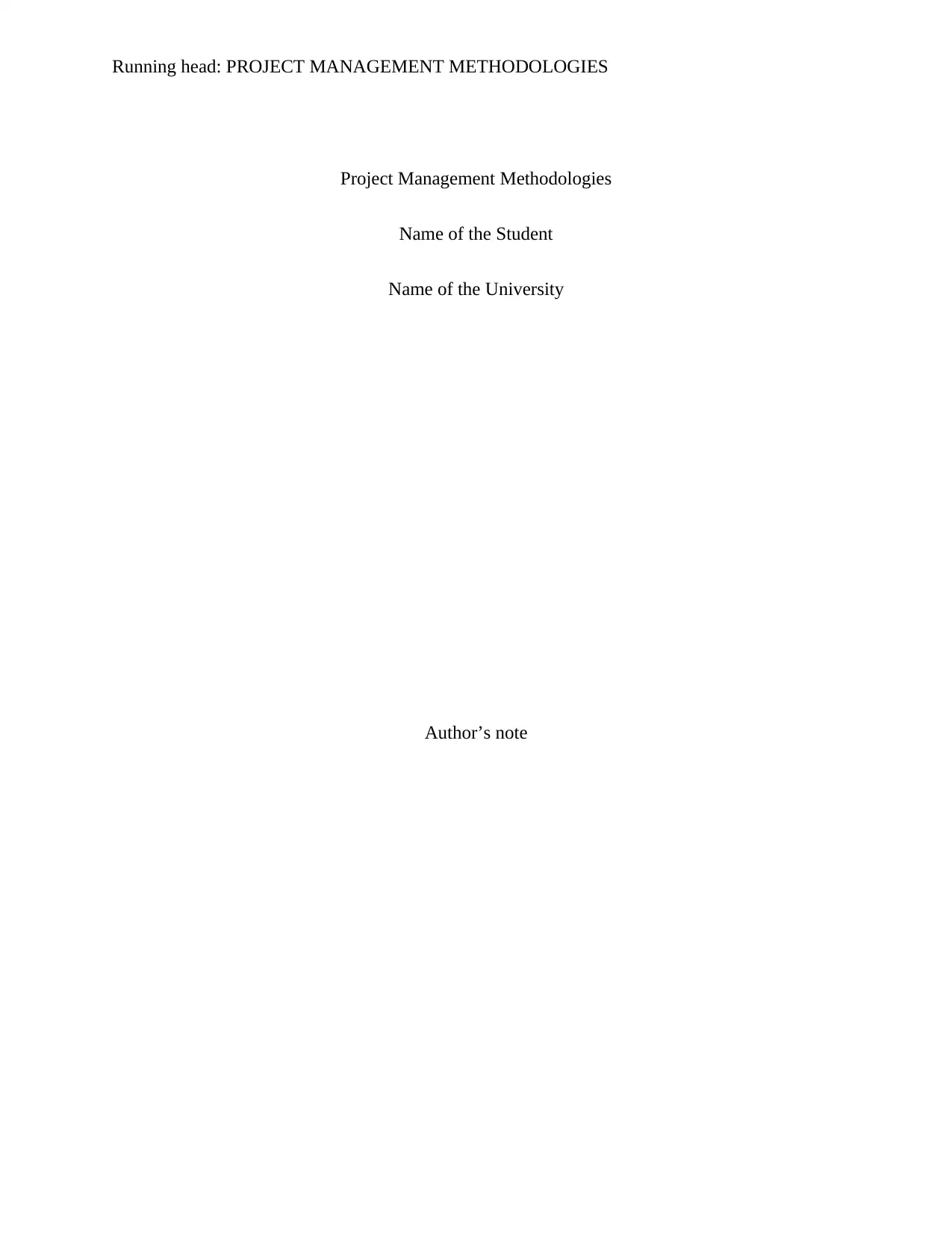
Running head: PROJECT MANAGEMENT METHODOLOGIES
Project Management Methodologies
Name of the Student
Name of the University
Author’s note
Project Management Methodologies
Name of the Student
Name of the University
Author’s note
Paraphrase This Document
Need a fresh take? Get an instant paraphrase of this document with our AI Paraphraser
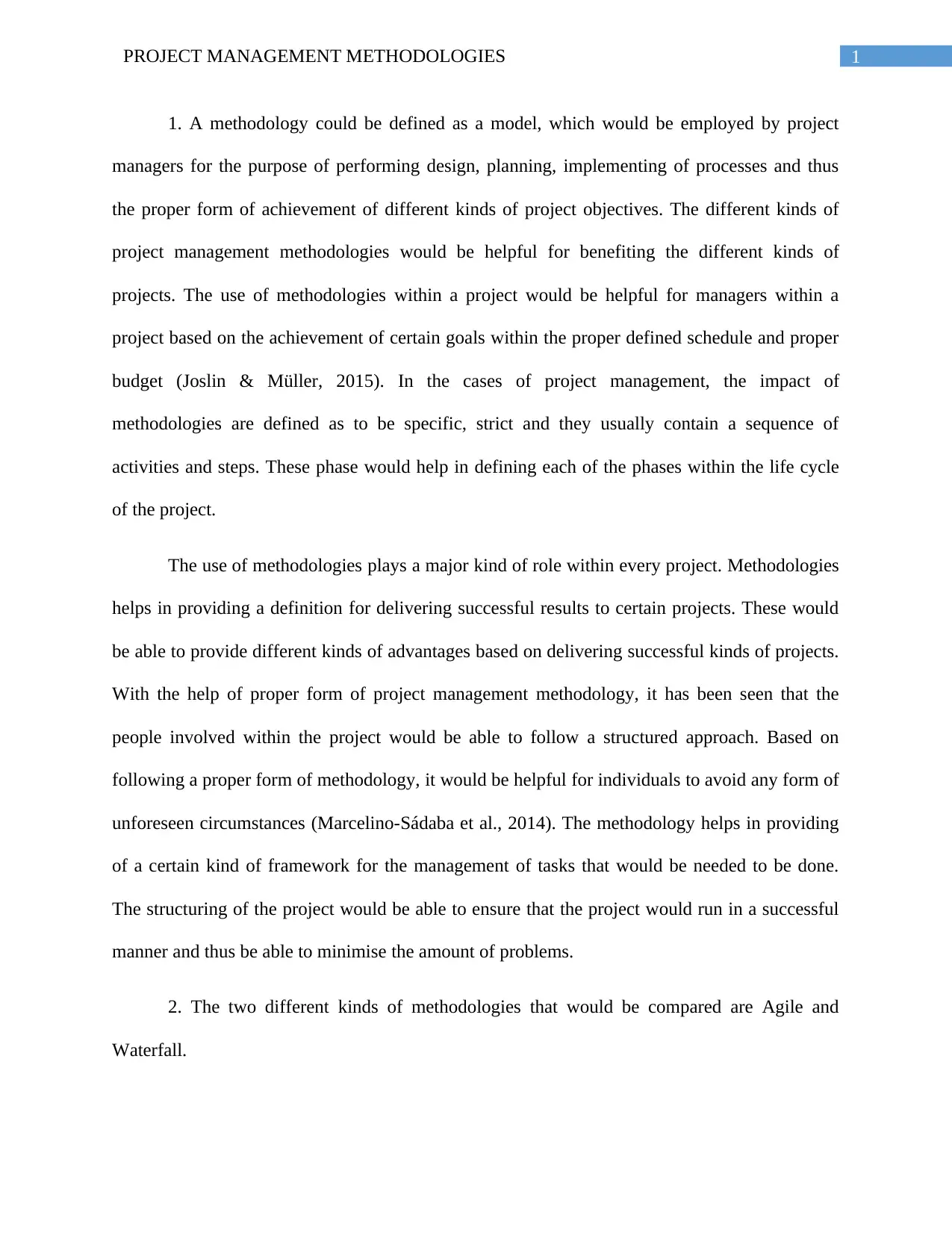
1PROJECT MANAGEMENT METHODOLOGIES
1. A methodology could be defined as a model, which would be employed by project
managers for the purpose of performing design, planning, implementing of processes and thus
the proper form of achievement of different kinds of project objectives. The different kinds of
project management methodologies would be helpful for benefiting the different kinds of
projects. The use of methodologies within a project would be helpful for managers within a
project based on the achievement of certain goals within the proper defined schedule and proper
budget (Joslin & Müller, 2015). In the cases of project management, the impact of
methodologies are defined as to be specific, strict and they usually contain a sequence of
activities and steps. These phase would help in defining each of the phases within the life cycle
of the project.
The use of methodologies plays a major kind of role within every project. Methodologies
helps in providing a definition for delivering successful results to certain projects. These would
be able to provide different kinds of advantages based on delivering successful kinds of projects.
With the help of proper form of project management methodology, it has been seen that the
people involved within the project would be able to follow a structured approach. Based on
following a proper form of methodology, it would be helpful for individuals to avoid any form of
unforeseen circumstances (Marcelino-Sádaba et al., 2014). The methodology helps in providing
of a certain kind of framework for the management of tasks that would be needed to be done.
The structuring of the project would be able to ensure that the project would run in a successful
manner and thus be able to minimise the amount of problems.
2. The two different kinds of methodologies that would be compared are Agile and
Waterfall.
1. A methodology could be defined as a model, which would be employed by project
managers for the purpose of performing design, planning, implementing of processes and thus
the proper form of achievement of different kinds of project objectives. The different kinds of
project management methodologies would be helpful for benefiting the different kinds of
projects. The use of methodologies within a project would be helpful for managers within a
project based on the achievement of certain goals within the proper defined schedule and proper
budget (Joslin & Müller, 2015). In the cases of project management, the impact of
methodologies are defined as to be specific, strict and they usually contain a sequence of
activities and steps. These phase would help in defining each of the phases within the life cycle
of the project.
The use of methodologies plays a major kind of role within every project. Methodologies
helps in providing a definition for delivering successful results to certain projects. These would
be able to provide different kinds of advantages based on delivering successful kinds of projects.
With the help of proper form of project management methodology, it has been seen that the
people involved within the project would be able to follow a structured approach. Based on
following a proper form of methodology, it would be helpful for individuals to avoid any form of
unforeseen circumstances (Marcelino-Sádaba et al., 2014). The methodology helps in providing
of a certain kind of framework for the management of tasks that would be needed to be done.
The structuring of the project would be able to ensure that the project would run in a successful
manner and thus be able to minimise the amount of problems.
2. The two different kinds of methodologies that would be compared are Agile and
Waterfall.
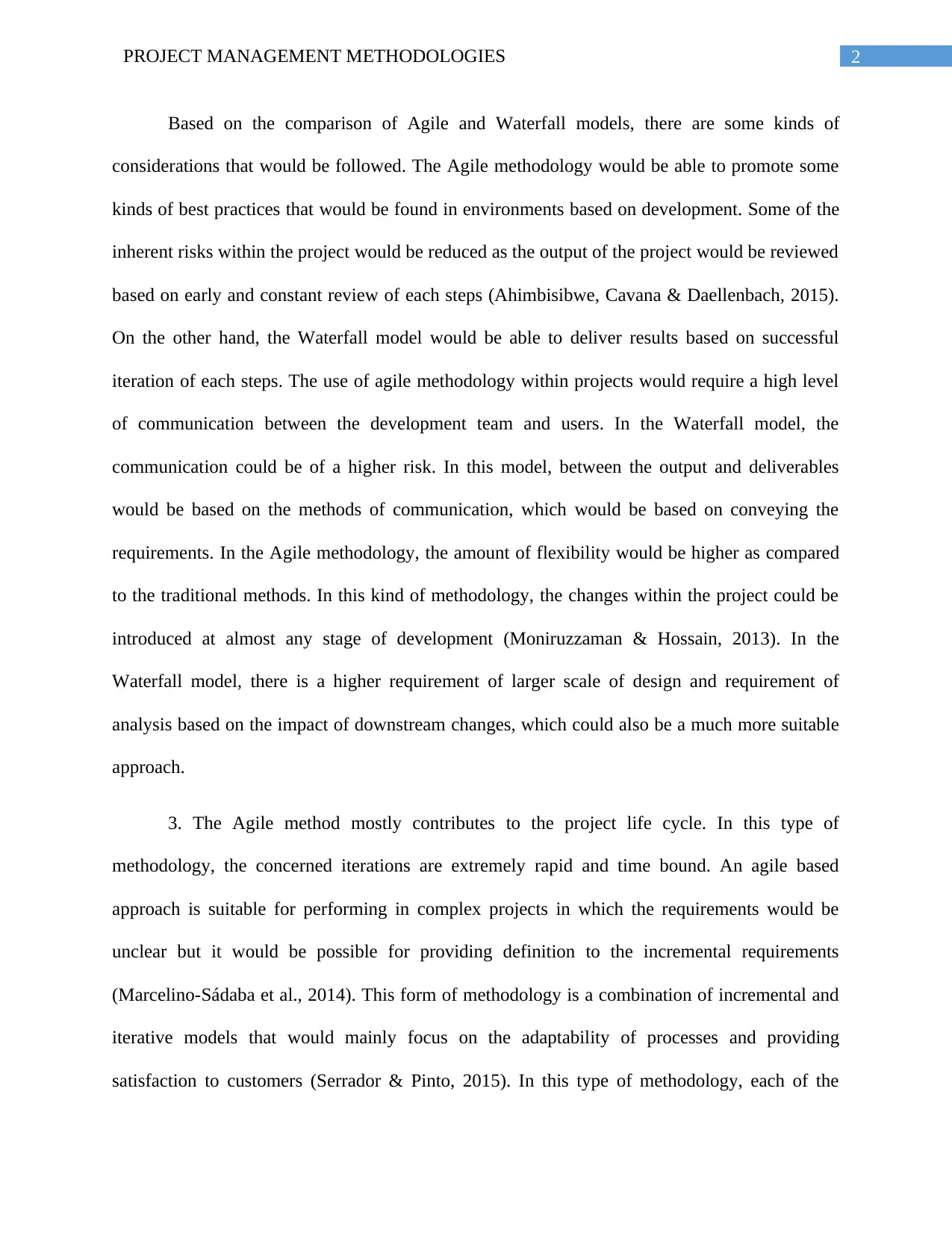
2PROJECT MANAGEMENT METHODOLOGIES
Based on the comparison of Agile and Waterfall models, there are some kinds of
considerations that would be followed. The Agile methodology would be able to promote some
kinds of best practices that would be found in environments based on development. Some of the
inherent risks within the project would be reduced as the output of the project would be reviewed
based on early and constant review of each steps (Ahimbisibwe, Cavana & Daellenbach, 2015).
On the other hand, the Waterfall model would be able to deliver results based on successful
iteration of each steps. The use of agile methodology within projects would require a high level
of communication between the development team and users. In the Waterfall model, the
communication could be of a higher risk. In this model, between the output and deliverables
would be based on the methods of communication, which would be based on conveying the
requirements. In the Agile methodology, the amount of flexibility would be higher as compared
to the traditional methods. In this kind of methodology, the changes within the project could be
introduced at almost any stage of development (Moniruzzaman & Hossain, 2013). In the
Waterfall model, there is a higher requirement of larger scale of design and requirement of
analysis based on the impact of downstream changes, which could also be a much more suitable
approach.
3. The Agile method mostly contributes to the project life cycle. In this type of
methodology, the concerned iterations are extremely rapid and time bound. An agile based
approach is suitable for performing in complex projects in which the requirements would be
unclear but it would be possible for providing definition to the incremental requirements
(Marcelino-Sádaba et al., 2014). This form of methodology is a combination of incremental and
iterative models that would mainly focus on the adaptability of processes and providing
satisfaction to customers (Serrador & Pinto, 2015). In this type of methodology, each of the
Based on the comparison of Agile and Waterfall models, there are some kinds of
considerations that would be followed. The Agile methodology would be able to promote some
kinds of best practices that would be found in environments based on development. Some of the
inherent risks within the project would be reduced as the output of the project would be reviewed
based on early and constant review of each steps (Ahimbisibwe, Cavana & Daellenbach, 2015).
On the other hand, the Waterfall model would be able to deliver results based on successful
iteration of each steps. The use of agile methodology within projects would require a high level
of communication between the development team and users. In the Waterfall model, the
communication could be of a higher risk. In this model, between the output and deliverables
would be based on the methods of communication, which would be based on conveying the
requirements. In the Agile methodology, the amount of flexibility would be higher as compared
to the traditional methods. In this kind of methodology, the changes within the project could be
introduced at almost any stage of development (Moniruzzaman & Hossain, 2013). In the
Waterfall model, there is a higher requirement of larger scale of design and requirement of
analysis based on the impact of downstream changes, which could also be a much more suitable
approach.
3. The Agile method mostly contributes to the project life cycle. In this type of
methodology, the concerned iterations are extremely rapid and time bound. An agile based
approach is suitable for performing in complex projects in which the requirements would be
unclear but it would be possible for providing definition to the incremental requirements
(Marcelino-Sádaba et al., 2014). This form of methodology is a combination of incremental and
iterative models that would mainly focus on the adaptability of processes and providing
satisfaction to customers (Serrador & Pinto, 2015). In this type of methodology, each of the
⊘ This is a preview!⊘
Do you want full access?
Subscribe today to unlock all pages.

Trusted by 1+ million students worldwide
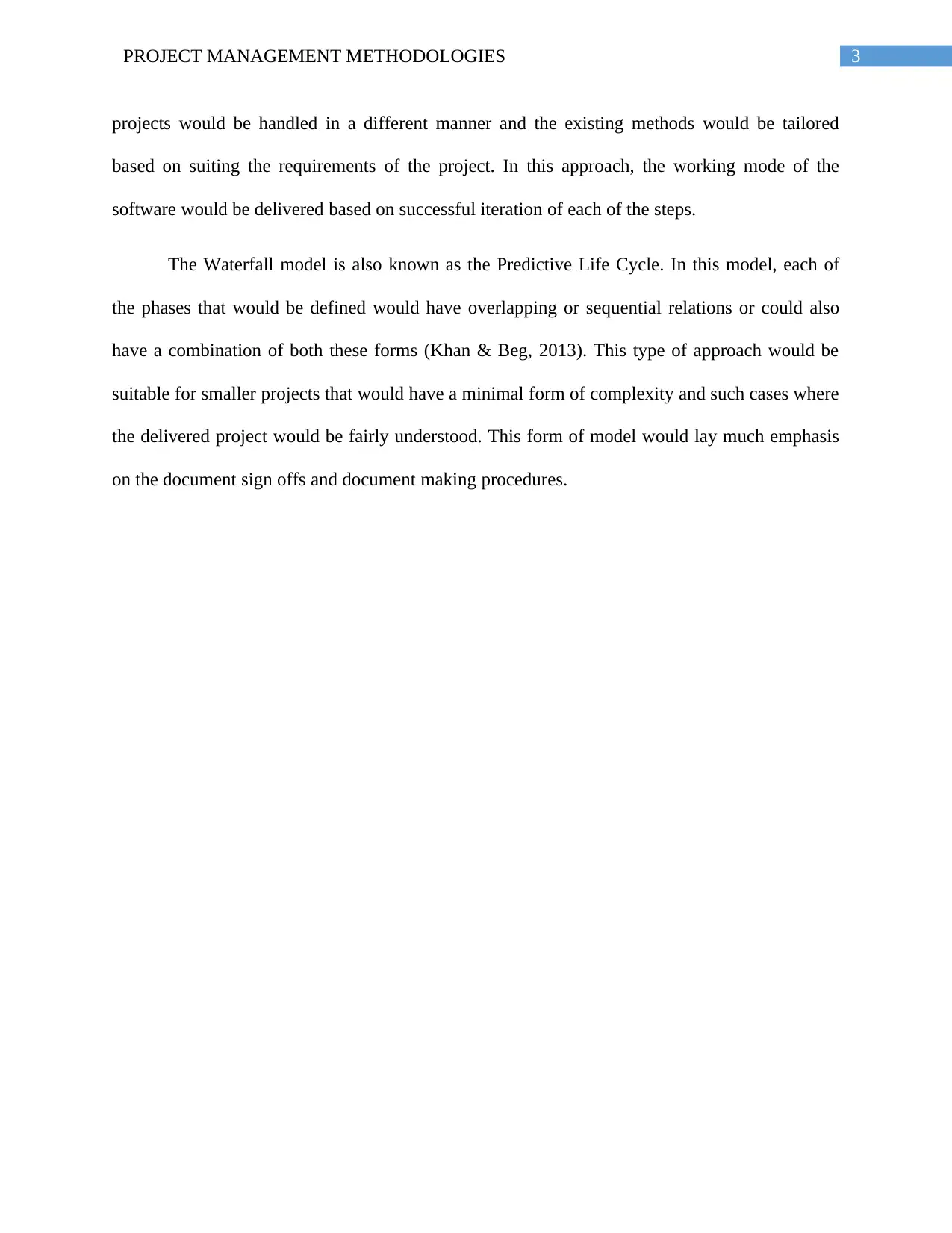
3PROJECT MANAGEMENT METHODOLOGIES
projects would be handled in a different manner and the existing methods would be tailored
based on suiting the requirements of the project. In this approach, the working mode of the
software would be delivered based on successful iteration of each of the steps.
The Waterfall model is also known as the Predictive Life Cycle. In this model, each of
the phases that would be defined would have overlapping or sequential relations or could also
have a combination of both these forms (Khan & Beg, 2013). This type of approach would be
suitable for smaller projects that would have a minimal form of complexity and such cases where
the delivered project would be fairly understood. This form of model would lay much emphasis
on the document sign offs and document making procedures.
projects would be handled in a different manner and the existing methods would be tailored
based on suiting the requirements of the project. In this approach, the working mode of the
software would be delivered based on successful iteration of each of the steps.
The Waterfall model is also known as the Predictive Life Cycle. In this model, each of
the phases that would be defined would have overlapping or sequential relations or could also
have a combination of both these forms (Khan & Beg, 2013). This type of approach would be
suitable for smaller projects that would have a minimal form of complexity and such cases where
the delivered project would be fairly understood. This form of model would lay much emphasis
on the document sign offs and document making procedures.
Paraphrase This Document
Need a fresh take? Get an instant paraphrase of this document with our AI Paraphraser
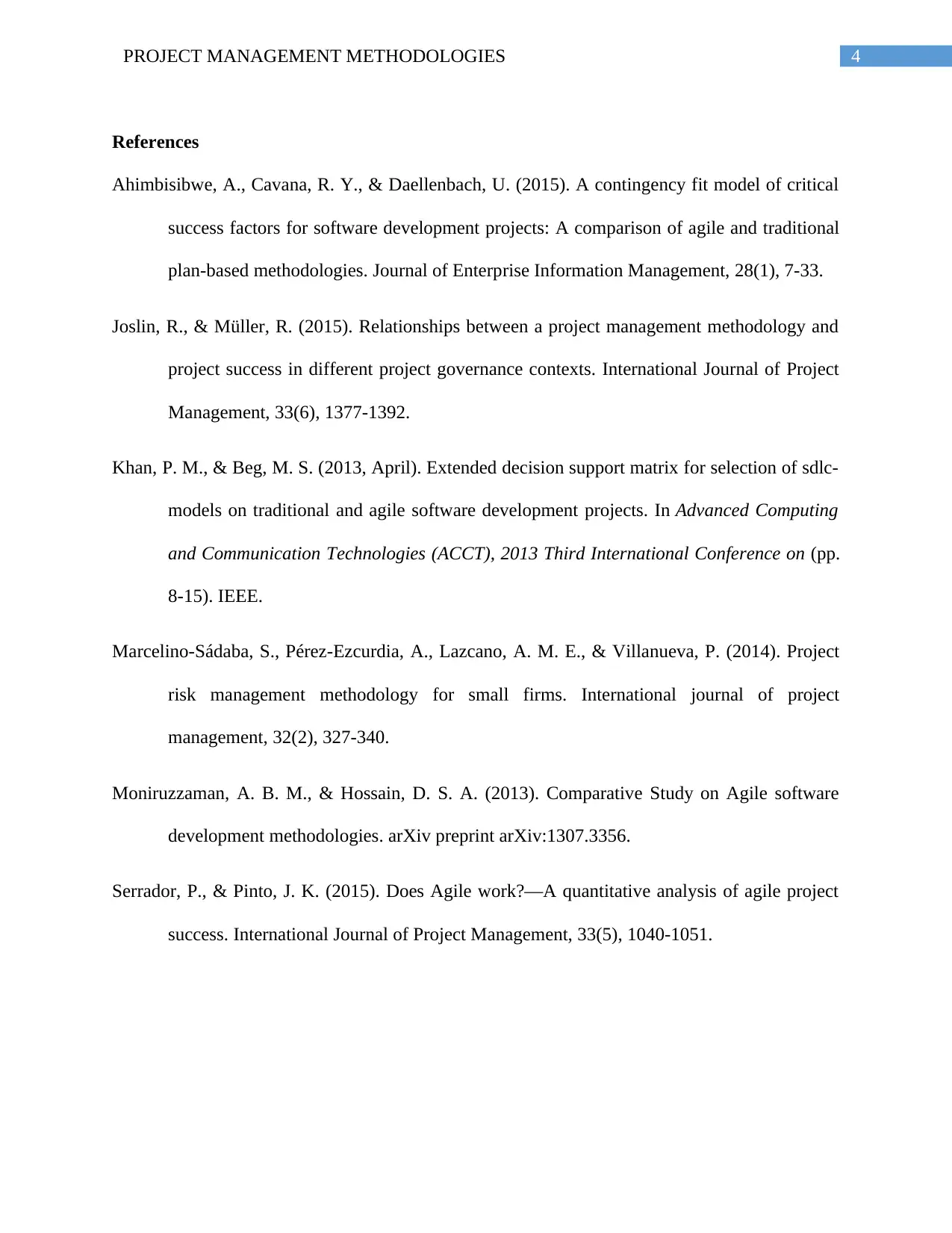
4PROJECT MANAGEMENT METHODOLOGIES
References
Ahimbisibwe, A., Cavana, R. Y., & Daellenbach, U. (2015). A contingency fit model of critical
success factors for software development projects: A comparison of agile and traditional
plan-based methodologies. Journal of Enterprise Information Management, 28(1), 7-33.
Joslin, R., & Müller, R. (2015). Relationships between a project management methodology and
project success in different project governance contexts. International Journal of Project
Management, 33(6), 1377-1392.
Khan, P. M., & Beg, M. S. (2013, April). Extended decision support matrix for selection of sdlc-
models on traditional and agile software development projects. In Advanced Computing
and Communication Technologies (ACCT), 2013 Third International Conference on (pp.
8-15). IEEE.
Marcelino-Sádaba, S., Pérez-Ezcurdia, A., Lazcano, A. M. E., & Villanueva, P. (2014). Project
risk management methodology for small firms. International journal of project
management, 32(2), 327-340.
Moniruzzaman, A. B. M., & Hossain, D. S. A. (2013). Comparative Study on Agile software
development methodologies. arXiv preprint arXiv:1307.3356.
Serrador, P., & Pinto, J. K. (2015). Does Agile work?—A quantitative analysis of agile project
success. International Journal of Project Management, 33(5), 1040-1051.
References
Ahimbisibwe, A., Cavana, R. Y., & Daellenbach, U. (2015). A contingency fit model of critical
success factors for software development projects: A comparison of agile and traditional
plan-based methodologies. Journal of Enterprise Information Management, 28(1), 7-33.
Joslin, R., & Müller, R. (2015). Relationships between a project management methodology and
project success in different project governance contexts. International Journal of Project
Management, 33(6), 1377-1392.
Khan, P. M., & Beg, M. S. (2013, April). Extended decision support matrix for selection of sdlc-
models on traditional and agile software development projects. In Advanced Computing
and Communication Technologies (ACCT), 2013 Third International Conference on (pp.
8-15). IEEE.
Marcelino-Sádaba, S., Pérez-Ezcurdia, A., Lazcano, A. M. E., & Villanueva, P. (2014). Project
risk management methodology for small firms. International journal of project
management, 32(2), 327-340.
Moniruzzaman, A. B. M., & Hossain, D. S. A. (2013). Comparative Study on Agile software
development methodologies. arXiv preprint arXiv:1307.3356.
Serrador, P., & Pinto, J. K. (2015). Does Agile work?—A quantitative analysis of agile project
success. International Journal of Project Management, 33(5), 1040-1051.
1 out of 5
Related Documents
Your All-in-One AI-Powered Toolkit for Academic Success.
+13062052269
info@desklib.com
Available 24*7 on WhatsApp / Email
![[object Object]](/_next/static/media/star-bottom.7253800d.svg)
Unlock your academic potential
Copyright © 2020–2025 A2Z Services. All Rights Reserved. Developed and managed by ZUCOL.

